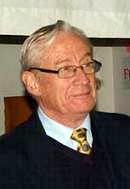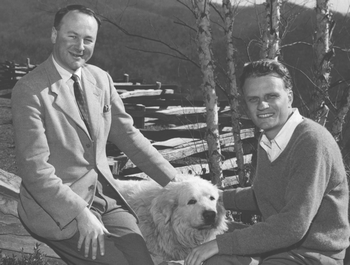 David Claydon
David Claydon
At the St Paul's Cathedral Thanksgiving Service for the life of John R.W. Stott held on 13 January 2012, an insert with the service sheet suggested that John will be remembered 'as an outstanding biblical preacher … as a strategic leader of the worldwide evangelical movement, as a prolific writer, and as a model of Christlikeness and personal friendship.'
These personal, God-given gifts were a linking factor in bringing together John Stott and Billy Graham. They came together in 1955 when Dr Graham was invited to lead a mission at Cambridge University and John Stott assisted him. In the years that followed their friendship grew and they expressed to each other the need strongly to promote the most important task for all Christians, namely to be involved in the evangelisation of the world. Their discussions led them to conceive of an International Congress of Church leaders from around the world to meet together and consider how they could all be involved in world evangelisation. Billy Graham's staff team worked on a Congress program and it was considered that the way forward would be to have a Covenant which expresses the most important biblical principles agreed to by those committed to Christ's calling to take the gospel to the world (cf Matt 28:18-20 and Acts 1:8, 11).
Speakers were invited and asked to present their talk in writing some weeks beforehand to enable the Congress team to draw up a draft Covenant. Dr Graham and his team decided to ask Dr John Stott to be the 'chief Architect' of this Covenant. Here was a person who was totally committed to evangelism and to the authority of Scripture. He was also known to be an amazingly able expositor of the Bible and had the skill of explicit expression of theological teaching. Both Graham and Stott wanted to challenge church leaders to put aside unnecessary divisions and work towards some unity in our biblical commitment to evangelism.
It was determined to hold a major gathering in Lausanne Switzerland in July 1974 and 2,700 participants from 150 countries attended the Congress. These participants represented the whole spectrum of Protestant denominations and as Time magazine of 5 August 1974 said, 'it was a formidable forum.' Jack Dain (later Bishop Dain) was Chairman of the Congress and he asked me to find some younger leaders to come to the Congress. So I invited some 30 leaders from youth ministries in UK, Argentina and Australia. We met for a few days in Geneva to get to know each other and agreed to meet every day after the morning plenary session to evaluate the talks and how the teaching could be used in our own ministries and in reaching out to young people in our country. When we got to the Congress hall we found an ideal spot to meet: 'under the clock'. We called ourselves the Radical Discipleship Group.
 On the fourth day of the Congress we all received a copy of the draft Covenant. We were thrilled with most of it. It had the clarity we needed in expressing the significant biblical grounds for evangelism which we needed to teach the younger generation, but it failed in one area. It made no reference to the thrust of two plenary sessions, led by Padilla and Escobar which focused on giving expression to the love (agape) of the gospel in ways that could meet the practical needs of any listener. Both these men were in my Radical Discipleship Group, so you can see why we were concerned! Yet we could also see that the proposed Covenant exemplified Stott's scholarship and evangelistic passion. We were thrilled about this. A number of us knew John personally and so we weren't concerned about the possibility of raising our issue with him. However, we knew for our part that we would have to express ourselves in a thoughtful and helpful way.
On the fourth day of the Congress we all received a copy of the draft Covenant. We were thrilled with most of it. It had the clarity we needed in expressing the significant biblical grounds for evangelism which we needed to teach the younger generation, but it failed in one area. It made no reference to the thrust of two plenary sessions, led by Padilla and Escobar which focused on giving expression to the love (agape) of the gospel in ways that could meet the practical needs of any listener. Both these men were in my Radical Discipleship Group, so you can see why we were concerned! Yet we could also see that the proposed Covenant exemplified Stott's scholarship and evangelistic passion. We were thrilled about this. A number of us knew John personally and so we weren't concerned about the possibility of raising our issue with him. However, we knew for our part that we would have to express ourselves in a thoughtful and helpful way.
I suggested that we call an ad hoc group and meet that evening after the last session. I asked Jack Dain if such a meeting would be possible and would he announce it. He allocated a room for us and he did announce the extra session and we had over 800 attend. I interviewed various leaders and at lights out the Radical Discipleship group met and worked out a possible wording to be added to the Covenant. The following day I met with John Stott and shared the suggested wording for a new paragraph.
In his gracious way he was open to the need for a challenging statement and we discussed it in detail. We were interrupted by some pastors who strongly objected to any such suggestion as they were genuinely fearful of a social gospel. However, John could see that there was a clear emphasis in the plenary sessions on the need to demonstrate the love of Christ as Christ himself had done by meeting people at their point of need. So our wording became clause 5 in the Covenant and this revised Covenant was issued two days later.1 It is quite clear that the Scriptures commands us to do justice, love mercy, and walk humbly with our God.
Due to the concern of the pastors who talked with John and me against any reference to 'social ministry', John produced a small book the next year entitled Balanced Christianity: A Call to Avoid Unnecessary Polarisation. John, all of us in the radical group, and many others, were very concerned about a strong division of opinion in the evangelical community about both preaching and demonstrating the gospel. John himself could see how this division of opinion could 'bedevil our effective witness'. In this book John urged, 'in things essential, unity, in things doubtful, liberty, in all things charity.'
Stott's clarity of thought and his ability to focus clearly on biblical injunctions enabled the Congress to identify the most important task which all followers of Jesus should have. The Lausanne Covenant is a very solemn personal commitment. It commits us to concrete and sacrificial action. It is the challenge the whole church needs to be obedient to the Lord. The outcome was the decision to have a continuing organisation to promote this challenge. Hence the whole conference signed the Covenant and agreed to appoint a continuing Lausanne Committee. This covenant has proven to be 'the most significant document in modern church history … it served as a great rallying call to the evangelical church around the world. It defined what it means to be evangelical, and challenged Christians to work together to make Jesus Christ known throughout the world.2
John Stott continued to serve the now established Lausanne Movement and was involved in writing a manifesto which emerged from the Lausanne II Congress in Manila. This manifesto helped to resolve tensions in a rapidly changing world. John was a radical visionary and he was free to highlight through this manifesto evangelical tensions and new global concerns. He has challenged us all to think strategically about ways of responding to new environmental and political demands.
Dr Billy Graham said that Stott 'represents a touchstone of authentic biblical scholarship'3 . We thank the Lord for giving us John Stott with his gifts and commitment and the expression of these gifts in the power of the Holy Spirit through Lausanne and through his numerous
books.
NOTES
